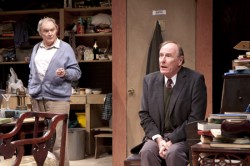In today’s Wall Street Journal I review the American premiere of The Habit of Art, Alan Bennett’s latest play, at Washington’s Studio Theatre. Here’s an excerpt.
* * *
Alan Bennett has a knack for writing big, complicated plays that are, like “The History Boys” and “The Madness of George III,” both challenging and entertaining. “The Habit of Art,” a fictional portrayal of the uneasy relationship between W.H. Auden and Benjamin Britten, fills the bill on all counts. Though the scale of the play (one set, two acts) is modest, “The Habit of Art” sprawls all over the place. But Mr. Bennett’s latest play is so excitingly written that you won’t find it hard to forgive its failings, and Washington’s Studio Theatre has given it a production so polished that it could open on Broadway as is.
 “The Habit of Art” is set at a rehearsal of “Caliban’s Day,” an imaginary docudrama about Auden, Britten and Humphrey Carpenter, who wrote biographies of both men. In the play-within-the-play, the fictional Carpenter (Cameron Folmar) pays a visit to the fictional Auden (Ted van Griethuysen) to interview him about the fictional Britten (Paxton Whitehead). Then Britten pays a visit to Auden, whom he hasn’t seen in person for 20 years, to ask the poet’s advice about the operatic version of “Death in Venice” on which he is working. Their awkward reunion is interrupted by the arrival of a young male prostitute (Randy Harrison) who has a date with Auden and in whom Britten takes a furtive interest.
“The Habit of Art” is set at a rehearsal of “Caliban’s Day,” an imaginary docudrama about Auden, Britten and Humphrey Carpenter, who wrote biographies of both men. In the play-within-the-play, the fictional Carpenter (Cameron Folmar) pays a visit to the fictional Auden (Ted van Griethuysen) to interview him about the fictional Britten (Paxton Whitehead). Then Britten pays a visit to Auden, whom he hasn’t seen in person for 20 years, to ask the poet’s advice about the operatic version of “Death in Venice” on which he is working. Their awkward reunion is interrupted by the arrival of a young male prostitute (Randy Harrison) who has a date with Auden and in whom Britten takes a furtive interest.
Around this more than sufficiently intriguing situation, Mr. Bennett has wrapped a backstage comedy about the process of rehearsing “Caliban’s Day” for production at London’s National Theatre. In addition to the cast of “Caliban’s Day,” we meet the vain, neurotic playwright (Wynn Harmon), the long-suffering stage manager (Margaret Daly) and various other familiar but knowingly drawn theatrical types. Imagine “Noises Off” rewritten by Tom Stoppard and you’ll get some notion of the havoc arising from the collision of play and play-within-a-play….
The rehearsal-room sequences of “The Habit of Art” are totally convincing, so much so that the play seems in the end to be more about theater itself than about Auden and Britten. The problem is that the contrast between Auden’s self-acceptance and Britten’s “occluded sexuality” (in Auden’s phrase) is the emotional engine that drives “The Habit of Art,” and Mr. Bennett has not made it dramatically compelling. Yet even when it falters, “The Habit of Art” holds your attention, and David Muse’s staging is so clearly articulated and full of crisp comic energy that you’ll have no difficulty picking your way through the thickets of Mr. Bennett’s labyrinthine plot….
* * *
Read the whole thing here.
Terry Teachout on the arts in New York City
